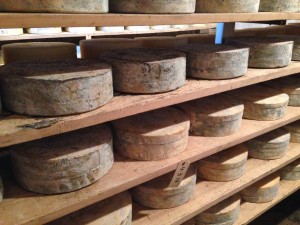The aim of this study was to analyze the changing patterns of Listeria monocytogenes contamination in a cheese processing facility manufacturing a wide range of ready-to-eat products. Characterization of L. monocytogenes isolates included genotyping by pulsed-field gel electrophoresis (PFGE) and multi-locus sequence typing (MLST).
 Disinfectant-susceptibility tests and the assessment of L. monocytogenes survival in fresh cheese were also conducted. During the sampling period between 2010 and 2013, a total of 1284 environmental samples were investigated. Overall occurrence rates of Listeria spp. and L. monocytogenes were 21.9% and 19.5%, respectively. Identical L. monocytogenes genotypes were found in the food processing environment (FPE), raw materials and in products. Interventions after the sampling events changed contamination scenarios substantially. The high diversity of globally, widely distributed L. monocytogenes genotypes was reduced by identifying the major sources of contamination.
Disinfectant-susceptibility tests and the assessment of L. monocytogenes survival in fresh cheese were also conducted. During the sampling period between 2010 and 2013, a total of 1284 environmental samples were investigated. Overall occurrence rates of Listeria spp. and L. monocytogenes were 21.9% and 19.5%, respectively. Identical L. monocytogenes genotypes were found in the food processing environment (FPE), raw materials and in products. Interventions after the sampling events changed contamination scenarios substantially. The high diversity of globally, widely distributed L. monocytogenes genotypes was reduced by identifying the major sources of contamination.
Although susceptible to a broad range of disinfectants and cleaners, one dominant L. monocytogenes sequence type (ST) 5 could not be eradicated from drains and floors. Significantly, intense humidity and steam could be observed in all rooms and water residues were visible on floors due to increased cleaning strategies. This could explain the high L. monocytogenes contamination of the FPE (drains, shoes and floors) throughout the study (15.8%). The outcome of a challenge experiment in fresh cheese showed that L. monocytogenes could survive after 14 days of storage at insufficient cooling temperatures (8 and 16 °C). All efforts to reduce L. monocytogenes environmental contamination eventually led to a transition from dynamic to stable contamination scenarios. Consequently, implementation of systematic environmental monitoring via in-house systems should either aim for total avoidance of FPE colonization, or emphasize a first reduction of L. monocytogenes to sites where contamination of the processed product is unlikely. Drying of surfaces after cleaning is highly recommended to facilitate the L. monocytogenes eradication.
International Journal of Food Microbiology, Volume 189, 17 October 2014, Pages 98–105, DOI: 10.1016/j.ijfoodmicro.2014.08.001
I. Rückerla, M. Muhterem-Uyara, S. Muri-Klingera, K.-H. Wagnerc, M. Wagnera, B. Stessl
http://www.sciencedirect.com/science/article/pii/S0168160514003924







